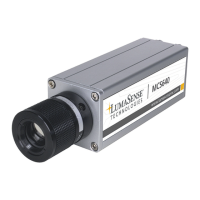MCS640 Thermal Imager Manual Principle of Thermal Imaging • 34
4. Comparison with blackbody surface — Option 1
A very small hole is made in the measured object to satisfy the aforementioned blackbody conditions,
and to make the temperature of the entire object uniform. Then, using the emissivity correcting
function of thermal imager, the emissivity is reduced until the temperature of the point to be
measured equals the temperature of the small hole measured at an emissivity of 1. The emissivity
setting should be the emissivity of the object. (This applies only when the conditions are the same as
at measurement.)
5. Comparison with blackbody surface — Option 2
If a small hole cannot be made in the object, then the emissivity can be obtained by applying black
paint to the object and reaching a thermal equilibrium through similar procedures. But since the
painted object will not provide a complete blackbody, the emissivity of the painted object needs to be
set first and then the temperature can be measured. The following figure shows examples of
blackbody paint.
4.6 Background Noise
When measuring the temperature of an object by a radiation thermometer, it is important to take into
consideration the above-mentioned emissivity correction as well as the environmental conditions where the
measurements will be performed.
Infrared rays enter the thermal imager from the measuring object as well as all other objects nearby.
Therefore, in order to avoid this influence, a function of environment reflection correction, etc. is required.
Also, when accurate data is required, it is necessary to minimize the influence by shortening the transmission
route of the infrared ray, for example.
Note: For low temperatures, masking tape or cornstarch can be used.
The following methods may be useful to reduce background noise.
1. Shorten the distance between the measured object and of the thermal imager. Please keep a safe
distance to protect the operator as well as the instrument.
2. Have no high temperature object behind the measured object, such as the sun shining on the back of
the measured object.
3. Do not allow direct sunlight to strike thermal imager.
4. Do not allow obstacles such as dust or vapor (which attenuates the infrared signal) between the
measured object and the thermal imager.
4.7 Practical Measurement
There are a number of methods for correcting emissivity in order to obtain the true temperature. The
correction procedure with each method will be explained next.
Note: If you already know the emissivity, you can make thermal imaging measurements
immediately.

